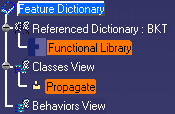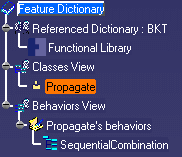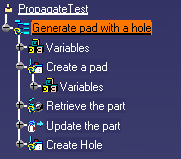 |
-
From the Start>Knowledgeware menu, access the
Business Process Knowledge Template workbench.
-
Create the PropagateUseCase technological
type.
|
|
|
|
|
|
 |
At this stage of the scenario, your feature
dictionary is similar to the graphic opposite. |
 |
-
Click The Propagate type and click the Sequential
Combination behavior ( )
to create a combination of behaviors. )
to create a combination of behaviors.
 |
At this stage of the scenario, your feature
dictionary is similar to the graphic opposite.
|
 |
-
Double-click SequentialCombination in the Behaviors View
and Propagate in the Behaviors tab to access the sequential combination.
-
Double-click the SequentialCombination node that is
displayed in the Behaviors tab. (Expand the Propagate node if need be.)
-
Enter the name of the combination, Generate pad with
a hole in this scenario, in Name field of the opening
dialog box and click OK to validate.
-
Select the Generate pad with a hole combination in
the Behaviors tree and click the VB Script Behavior icon ( ). ).
-
Double-click VBScript and enter Create a Pad in the
Name field and select
BktCreatePad.CATScript in the VB Name field.
-
Select the Generate pad with a hole combination in
the Behaviors tree and click the Bind Object Behavior icon ( ). ).
-
Double-click the BindObject behavior. The Bind Object
window is displayed. In the Name field, enter Retrieve
the part and enter ../../.. in the Relative Name field. Click
OK to validate.
-
Click the Generate pad with a hole combination and click
the Propagate Execution icon ( ).
A PropagateExecution behavior is displayed in the Behaviors tab. ).
A PropagateExecution behavior is displayed in the Behaviors tab.
-
Double-click this behavior and enter Update the part
in the Name field of the opening dialog box.
-
Select the Target field, expand the BindObject
variables node and select the output link. =BindObject\Link
is displayed in the Target field.
-
Select the Generate pad with a hole combination in
the Behaviors tree and click the VB Script Behavior icon ( ). ).
-
Double-click VBScript and enter Create a Pad
in the Name field and select
BktCreateHole.CATScript in
the VB Name field.
 |
At this stage of the scenario, the Behaviors tab is
similar to the graphic opposite. |
 |
The definition of the behaviors is now over. Save your file and
generate your workbench. (Click here
to display the generated .CATfct file).
-
Click the Applicative Workbench Generation
icon ( )
to generate a user workbench. Enter the name of the workbench in the
Workbench name field, Propagate Update in this example, an select
the workbench type, Part here. )
to generate a user workbench. Enter the name of the workbench in the
Workbench name field, Propagate Update in this example, an select
the workbench type, Part here.
-
From the Tools>Options>Knowledgeware>Business
Knowledge Template menu, select All Users from the
Access Rights scrolling list and click OK to work in a User
environment.
-
Open the
BktPart_with_Sketch.CATPart part and access the Propagate Update
workbench from the Start menu.
-
Select Part1 in the specification tree and select the
Propagate check box to type the root part. Its name is now
Propagate(Part1).
-
Right-click Propagate(part1) and select
Propagate(Part1) object>Generate pad with a hole.
The combination is executed and the following message is displayed.
-
Click OK. The hole is created (see picture
below.)
-
Close your file and go back to your CATfct file.
-
In the Behaviors tab, double-click the Propagate
Execution behavior (Update the part) and select the Action Delayed
check box. This way, the update of the part will not be launched. Save
your file.
-
Open the
BktPart_with_Sketch.CATPart part and access the Propagate Update
workbench from the Start menu.
-
Select Part1 in the specification tree and select the
Propagate check box to type the root part. Its name is now
Propagate(Part1).
-
Right-click Propagate(part1) and select
Propagate(Part1) object>Generate pad with a hole. The following
message is displayed.
-
Click OK. The hole is created (see picture
below.)
|
![]()